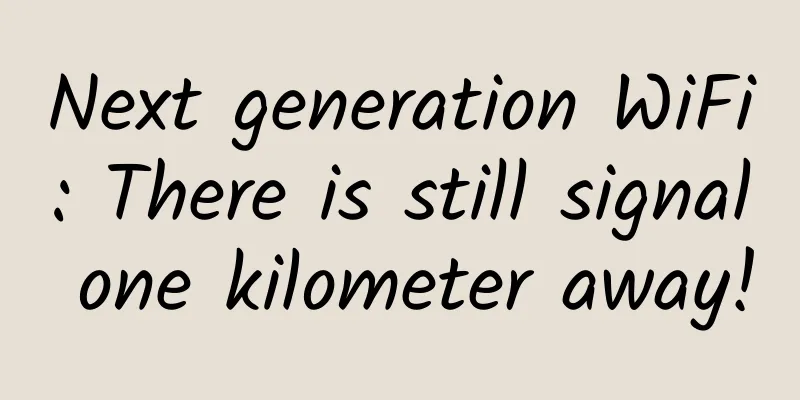Next generation WiFi: There is still signal one kilometer away!

|
The Wi-Fi Alliance announced on Tuesday the certification of Wi-Fi HaLow, a new feature that supports long-range, low-energy Wi-Fi transmissions in the sub-1GHz spectrum, promising a wall-penetrating range of more than 1 km. The feature is mainly aimed at smart home devices, as the number of cloud-connected devices worldwide is expected to surge to more than 30 billion by 2025, more than double the 13.8 billion IoT devices currently in use. That’s good news for smart home sensors, security cameras and industrial or agricultural IoT devices, and it’s good news for Wi-Fi, especially as new standards like Amazon Sidewalk and Matter try to gain a significant foothold in the smart home category, said Edgar Figueroa, president and CEO of the Wi-Fi Alliance. “Wi-Fi Certified HaLow further extends Wi-Fi’s leadership in IoT to address a host of new use cases that require longer range and lower power for secure and interoperable connectivity,” Figueroa said in a statement. “In the growing IoT market, opportunities to simplify connectivity are increasing, and Wi-Fi HaLow builds on the universally trusted foundation of Wi-Fi to pave the way for emerging IoT applications that benefit homes, businesses, and industries.” Wi-Fi HaLow claims longer range and lower power consumption because it sends signals at frequencies below 1GHz, which is much lower than the 2.4 and 5GHz bands used by most home Wi-Fi networks. While higher frequencies are better for moving large amounts of data, lower frequencies offer better range, which makes the sub-1GHz spectrum seem like a good fit for sensors and other devices that might need to send tiny bits of data across a long-distance Wi-Fi network. Additionally, Wi-Fi HaLow could be a boon for battery life, the Wi-Fi Alliance promises: "low-power connectivity required for applications including sensors, personal wearables, and utility meters that require multi-year battery operation." "Wi-Fi HaLow leverages existing Wi-Fi protocols and delivers many of the benefits consumers expect, including multi-vendor interoperability, strong WPA3 security, easy setup, and seamless integration with IP networks," the Wi-Fi Alliance added in its press release announcing HaLow certification. HaLow isn't the only new wireless standard that promises to drastically improve range. There's also Amazon Sidewalk, a low-power IoT network that launched earlier this year that relies on a combination of low-energy Bluetooth and LoRa signals. In this case, devices need to have their own LoRa radio to take advantage of the long-range connection. With Wi-Fi HaLow, devices only need a standardized Wi-Fi chipset that supports the protocol, and those should be available soon. Analysts note that Wi-Fi HaLow devices are already operating in the industrial sector, and they expect rapid adoption in residential and commercial environments in 2022. "Wi-Fi HaLow devices, such as security cameras and tablets, are currently being used in industrial settings, and we expect devices to soon find their way into smart home environments, enabling consumers to take advantage of their longer range and lower power for applications such as battery-powered cameras, video baby monitors, and other smart home products," said Phil Solis, research director at IDC. "Companies have been working on Wi-Fi HaLow chipsets for several years, and we expect shipments to surpass 10 million in 2022, with adoption expanding beyond the industrial space to include smart home, smart city, and retail markets." |
<<: China Mobile: More than 560,000 5G base stations have been built
>>: Daily Algorithm: Stair Climbing Problem
Recommend
Time is running out for NTP: Network Time Protocol may be gone forever
[51CTO.com Quick Translation] Everyone is enjoyin...
Huawei releases next-generation machine vision cameras and new products for 2020
[Hangzhou, China, May 25, 2020] Today, the Huawei...
My girlfriend didn't come home late at night for a long time, and I broke down after tapping her phone...
My girlfriend gets off work at 7 o'clock ever...
Why is the 4G network speed slowing down now? The Ministry of Industry and Information Technology gave the answer, netizens: It's really realistic
I don't know if you have noticed a significan...
Microsoft redesigns the calling interface in Teams
[[356857]] Microsoft Corp. has reportedly begun r...
New plan of the three major operators to increase speed and reduce fees! Be sincere, but be careful of "small tricks"
In the past four years of the implementation of t...
How to use gdb to accurately locate deadlock problems in multithreading
[[337631]] This article is reprinted from the WeC...
Wang Xijie, CEO of Yunfan Accelerator: Deeply cultivating network transmission and adhering to the "exquisite" route
[51CTO.com original article] As 2017 enters the c...
VXLAN and MPLS: From Data Center to Metro Ethernet
In recent years, the evolution of cloud computing...
XDP technology for high-performance network framework
1. Basic Concepts of XDP XDP stands for eXpress D...
Why does the HTTP request return 304?
[[402402]] I believe most web developers are fami...
What is the difference between MPLS and IP?
MPLS VS IP (1) IP forwarding principle: The route...
How to embrace the future with Network as a Service (NaaS)
In the digital age, the Internet has become an in...
2022 Gartner Online Fraud Market Guide Report is officially released, Ruishu Information is once again selected as a representative manufacturer
In December 2022, Gartner®, a global authoritativ...









